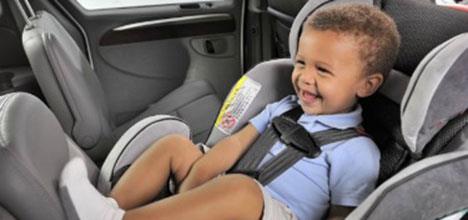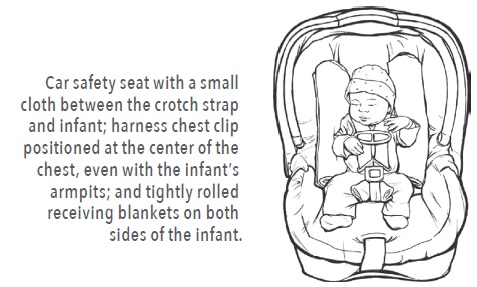What Are the Stages of Car Seats for Babies
Rear-Facing Car Seats for Infants & Toddlers


Folio Content
The AAP recommends that all infants ride rear facing starting with their first ride home from the hospital. All infants and toddlers should ride in a rear-facing seat every bit long as possible until they reach the highest weight or top allowed past their car safe seat manufacturer. Most convertible seats have limits that volition permit children to ride rear facing for 2 years or more. When infants outgrow their rear-facing–simply seat, a convertible seat installed rear facing is needed. All parents can benefit from getting installation assistance from a CPST to ensure that their kid's seat is properly installed.
Types of Rear-Facing Seats:
Iii types of rear-facing seats are available: rear-facing–simply, convertible, and all-in-one. When children reach the highest weight or length allowed by the manufacturer of their rear-facing–only seat, they should continue to ride rear facing in a convertible or all-in-one seat.
Rear-facing–only seats
- Are used for infants up to 22 to 35 pounds, depending on the model.
- Are small and take carrying handles.
- Unremarkably come with a base that tin be left in the machine. The seat clicks into and out of the base so you don't have to install the seat each time you utilize it. Parents tin can buy more than one base for additional vehicles.
- Should be used only for a child's travel (not sleeping, feeding, or any other utilize outside the vehicle).
Convertible seats (used rear facing)
- Can exist used rear facing and, after, "converted" to forward facing for older children when they outgrow either the weight limit or the length limit for rear facing. This ways the seat can exist used longer by your child. Convertible seats are bulkier than infant seats, however, and they practise not come with carrying handles or split up bases and are designed to stay in the car.
- Many have college limits in rear-facing weight (up to 40–fifty pounds) and height than those of rear-facing– only seats, a characteristic that makes convertible seats ideal for bigger babies and toddlers.
- Have a 5-bespeak harness that attaches at the shoulders, at the hips, and between the legs.
- Should be used only for a child's travel (not sleeping, feeding, or any other use outside the vehicle).
All-in-one seats (used rear facing)
- Can be used rear facing, frontwards facing, or as a belt- positioning booster. This means the seat may be used longer by your child as your child grows.
- Are oftentimes bigger in size, and so it is important to check that they fit in the vehicle while they are rear facing.
- Do not have the convenience of a carrying handle or dissever base; notwithstanding, they may have higher limits in rear-facing weight (upward to 40–50 pounds) and pinnacle than those of rear-facing–only seats, a feature that makes all-in-one seats ideal for bigger babies and toddlers.
Installation Tips for Rear-Facing Seats:
Always read the vehicle possessor's transmission and the car condom seat manual before installing the seat.
When using a rear-facing seat, keep the following tips in heed:
- Place the harnesses in your rear-facing seat in slots that are at or below your child's shoulders.
- Ensure that the harness is snug (you cannot pinch any slack between your fingers when testing the harness straps over the child's shoulders) and that the retainer clip is placed at the center of the breast, even with your child's armpits.
- Brand sure the motorcar rubber seat is installed tightly in the vehicle with either lower anchors or a locked seat chugalug. Many motorcar condom seats have an integrated lock-off to keep the seat belt locked. If your seat has 1, follow the manufacturer's recommendations on how to use information technology. If yous can motility the seat at the belt path more than an inch side to side or front end to back, it's non tight enough.
- Never place a rear-facing seat in the front seat of a vehicle that has an agile front passenger airbag. If the airbag inflates, it will hitting the back of the car safety seat, correct against your child's head, and could cause serious injury or death.
- If y'all are using a convertible or all-in-i seat in the rear-facing position, brand sure the seat chugalug or lower anchor webbing is routed through the correct chugalug path. Bank check the instructions that came with the car safety seat to be sure.
- Make certain the seat is at the correct bending so your child's head does not flop forward. Check the instructions to find out the correct bending for your seat and how to adjust the angle if needed. All rear-facing seats have congenital-in recline indicators.
- Bank check the motorcar safety seat instructions and vehicle owner'due south transmission about whether the automobile rubber seat may contact the back of the vehicle seat in front end of it.
- Nonetheless having trouble? Check with a certified CPST in your area who can aid. See If You Demand Installation Assist on page xvi for information on how to locate a CPST.
Common Questions:
What if my child's anxiety touch the back of the vehicle seat?
- This is a very common concern of parents, but it should cause them no worry. Children are very flexible and can always easily discover a comfortable position in a rear-facing seat. Injuries to the legs are very rare for children facing the rear.
What do I practice if my child slouches down or to the side in the car seat?

- Yous can try placing a tightly rolled receiving blanket on both sides of your child. Many manufacturers allow the utilise of a tightly rolled small diaper or cloth betwixt the crotch strap and your child, if necessary, to prevent slouching. Exercise not identify padding under or backside your kid or apply any sort of auto safety seat insert unless it came with the seat or was made by the manufacturer for utilise with that specific seat.
Why should I wearing apparel my child in thinner layers of clothing before strapping him or her into a car safety seat?
- Beefy clothing, including winter coats and snowsuits, can compress in a crash and go out the straps likewise loose to restrain your child, leading to increased adventure of injury. Ideally, clothes your babe in thinner layers and wrap a coat or blanket around your infant over the buckled harness straps if needed. See Winter Car Seat Safety Tips from the AAP.
Exercise preemies need a special motorcar seat?
A automobile safety seat should be approved for a baby'due south weight. Very small babies who can sit safely in a semi-reclined position ordinarily fit meliorate in rear-facing–just seats. Babies born preterm should be screened while nevertheless in the hospital to make sure they can sit safely in a semi-reclined position. Babies who demand to lie flat during travel may be able to ride in a motorcar bed that meets Federal Motor Vehicle Safety Standard 213. They should be screened over again while in the hospital to brand sure they can lie safely in the car bed.
Additional Data from HealthyChildren.org:
-
Heading Out With Babe
-
Shopping for Car Seats: Tips for Parents
-
Car Seats: Product Listing
Figure 1 from Bull MJ, Engle WA; American Academy of Pediatrics Committee on Injury, Violence, and Poisonous substance Prevention, Committee on Fetus and Newborn. Safe transportation of preterm and low birth weight infants at hospital discharge. Pediatrics. 2009;123(5);1424–1429.
Article Trunk
- Last Updated
- ii/28/2021
- Source
- Adapted from Motorcar Safety Seats Guide (Copyright © 2021 American Academy of Pediatrics)
The information independent on this Web site should not be used equally a substitute for the medical care and advice of your pediatrician. There may be variations in handling that your pediatrician may recommend based on individual facts and circumstances.
pepperthavercuris.blogspot.com
Source: https://www.healthychildren.org/English/safety-prevention/on-the-go/Pages/Rear-Facing-Car-Seats-for-Infants-Toddlers.aspx
0 Response to "What Are the Stages of Car Seats for Babies"
Post a Comment